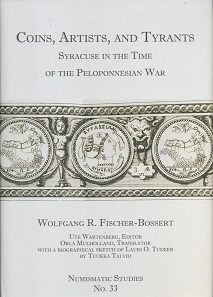by Ursula Kampmann
translated by Annika Backe
December 7, 2017 – The German language has a problem. Basically, it’s only understood by Germans, Austrians and Swiss people.* That wouldn’t be such a big deal if there weren’t several highly talented numismatists (and other researchers) among these Germans, Austrians and Swiss people who might well have something to contribute to the academic discussion. However, the result of this impractical language is that this goes unheard occasionally.
Wolfgang R. Fischer-Bossert, Ute Wartenberg (eds.), Coins, Artists, and Tyrants. Syracuse in the Time of the Peloponnesian War with selected passages from L. O. Tudeer, “Die Tetradrachmenprägung von Syrakus in der Periode der signierenden Künstler” translated by Orla Mulholland, and a biographical sketch about Tudeer by Tuukka Talvio. Numismatic Studies 33. The American Numismatic Society, New York 2017. 400 pages with b/w illustrations and 27 b/w plates. 21.5 x 30.5 cm. Hardcover, ISBN: 978-0-89722-341-6. $200 (ANS members: $140) plus postage.
You don’t believe me? Recently a lady from Australia contacted me via academia.edu, who was writing a paper on the didrachms of Taranto. She went into raptures about the theories she thought I had developed in a CoinsWeekly article (which had also been translated into English, of course). I had to disappoint the lady, though. I had neither developed the theories myself nor published them for the first time. I told her that she might want to have a look at Wolfgang Fischer-Bossert’s book on the chronology of the didrachm coinage of Taranto – which will generally be a good idea if you plan to write a study on the didrachms of Taranto. I did not got an answer yet; perhaps she is not happy about the fact that the most important secondary literature on her subject is written in a language she can’t master, in a form that you can’t feed into Google Translate.
With his new book, this won’t be a problem for Wolfgang Fischer-Bossert, even if it was born from a similar situation. A committed collector asked Ute Wartenberg for an English version of the excellent 1913 German catalog written by Lauri O. Th. Tudeer. When she started the work, Ute Wartenberg soon realized that you can’t reprint a 1913 book without annotations (if you have some academic aspirations, that is). And so, she brought Wolfgang Fischer-Bossert in. He has become the author of this book whereas Ute Wartenberg has served as its editor.
Even if Lauri Tudeer’s die study still forms the foundation of the work, it has been updated by recent research. Wolfgang Fischer-Bossert added several chapters spanning 100 pages in total: on the historical background, die combinations, epigraphy, imitations, and chronology based on hoard finds. In one chapter, which has the beautiful title “Views of Older Scholarship”, he renders the interpretations of past numismatists obsolete.
Tudeer’s catalog follows. It has been translated, adopted and enlarged with material yet unknown to the numismatist back then. The somewhat unusual arrangement we know from the original Tudeer has been adapted to accommodate modern viewing habits. But please don’t take over the dates given in the catalog! They are no longer correct. The series’ chronological range was shortened from 425-387 (Tudeer) to 415/4-395 (Fischer-Bossert).
Orla Mulholland has translated the Tudeer catalog into English; not only the catalog but the detailed comment by Lauri O. Th. Tudeer as well. An annotated bibliography, a concordance and indexes round out the work. The quality of the newly assembled plates also deserves special mentioning. Compared against the poor reprints of the 1913 original work – which (contrary to the reprints) hardly anybody possesses anyway – they facilitate the identification considerably.
The purchase thus pays off. We have a new standard work of reference on the Syracusan tetradrachms of the signing artists. And this time, author Wolfgang Fischer-Bossert can be pleased that he will be understood and received also by those who do not come from Germany, Austria or Switzerland.
You can order the book from the ANS.
European buyers are recommended to order it from Oxbow Books.
* I apologize to all my Dutch, Greek, Hungarian, Polish, and Swedish friends (I hope I haven’t forgotten anyone) who all speak German so fantastically! I know you can! If I had also mentioned all the exceptions, though, I would have lost the introduction’s punch line.





